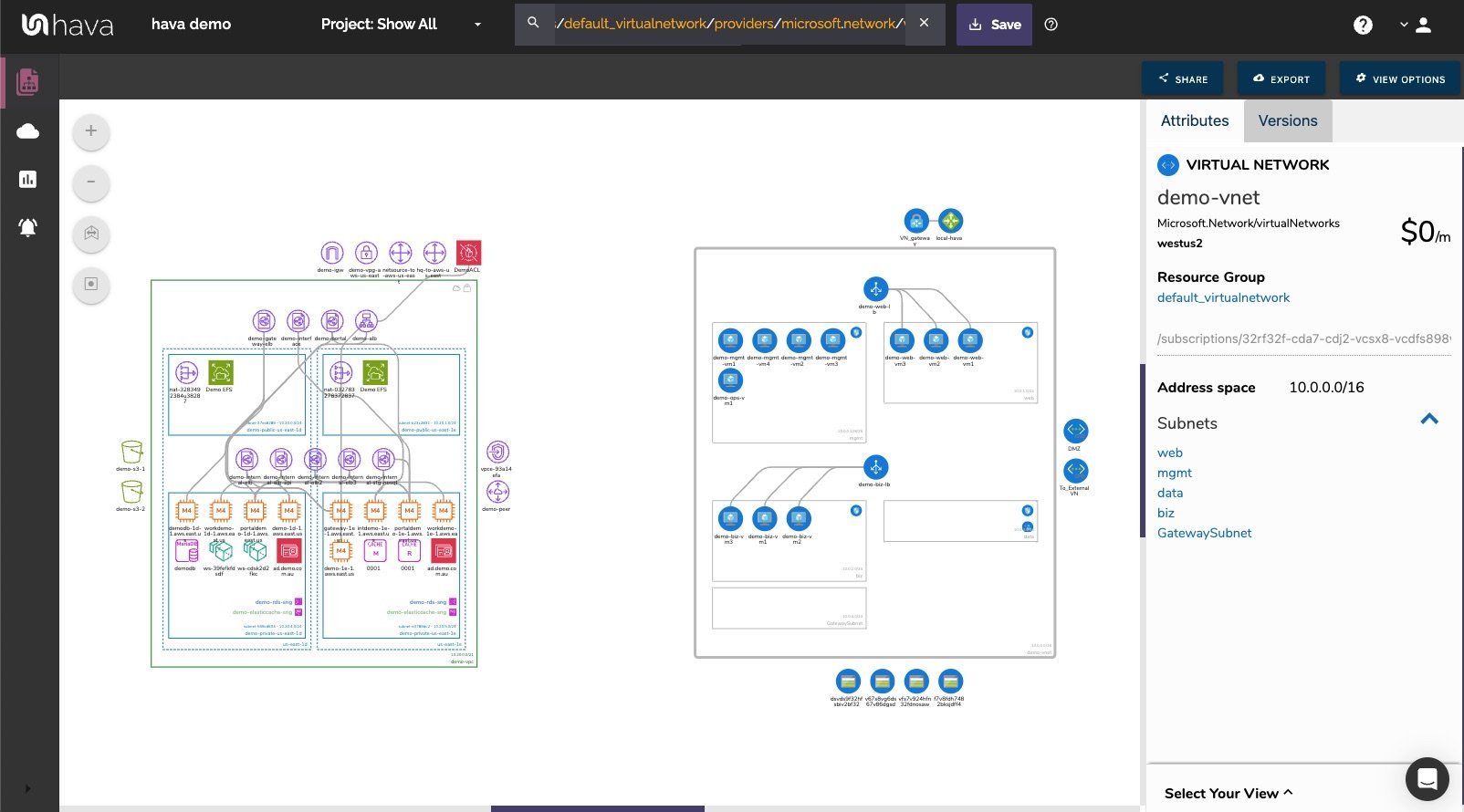
Introduction
Hybrid cloud architecture, which combine multiple cloud vendor services, offer businesses the flexibility to run their applications where it makes the most sense based on compliance, cost, and performance considerations. However, managing and optimizing these complex environments can be challenging without a clear visualization of the entire infrastructure. This is where Hava.io, a powerful tool for creating dynamic, automated cloud architecture diagrams, comes into play. This post explores the significance of visualizing hybrid cloud architecture and how Hava.io can facilitate this process effectively.
Understanding Hybrid Cloud Architecture
Hybrid cloud architecture involves the integration of public cloud platforms like AWS, Azure, or Google Cloud. The goal is to create a cohesive computing environment where applications and data can move seamlessly between public clouds and the best resources of each platform from a cost and performance aspect can be utilised. Effective management of this architecture requires a robust visualization tool for hybrid cloud diagramming that can provide insights into how these different environments interact and are configured.
The Importance of Visualizing Hybrid Cloud Architecture
Visual diagrams of hybrid cloud architecture are crucial for several reasons:
- Complexity Management: Hybrid environments are inherently complex, and visual diagrams can simplify the understanding of how components across diverse platforms are connected and interact.
- Security and Compliance: With the increasing emphasis on data privacy and regulatory standards, diagrams help ensure that all parts of the hybrid cloud comply with relevant laws and policies by clearly showing data flows and storage locations.
- Performance Optimization: Visual tools help identify bottlenecks and inefficiencies in the architecture, allowing IT teams to make informed decisions about where to allocate resources and how to improve system performance.
- Cost Management: Diagrams can highlight areas where costs can be optimized, such as redundant resources or underutilized services.
- Disaster Recovery Planning: Visual maps are essential for planning disaster recovery strategies, as they allow organizations to see critical dependencies and design systems that can remain operational in case of a failure.
- Operational Maintenance: Routine operations such as patching, updates, and migrations are easier to manage when there is a clear visual representation of the environments involved.
How Hava.io Enhances Hybrid Cloud Visualization
Hava.io stands out as a popular solution for diagramming hybrid cloud architecture due to its comprehensive set of features:
- Automated Diagram Generation: Hava.io automatically generates diagrams from real-time data sourced directly from cloud provider configurations. This automation ensures that the diagrams are always up-to-date and accurate.
- Interactive Diagrams: Unlike static images, Hava.io provides interactive diagrams that allow users to click on individual components to view detailed metadata. This feature is invaluable for in-depth analysis and troubleshooting.
- Multi-Cloud Integration: Hava.io supports all major cloud platforms providing a unified view of the entire hybrid environment.
- Real-Time Updates: As changes occur in the cloud infrastructure, Hava.io updates diagrams in real-time, reflecting the current state of the environment without manual intervention.
- Security Visualization: Hava.io diagrams include detailed views of security settings, such as firewalls and access controls, helping to ensure that the hybrid cloud architecture adheres to security best practices.
- Version Control and Historical Views: The tool maintains a version history for each diagram, allowing teams to track changes over time and revert to previous versions when necessary.
FAQs about Visualizing Hybrid Cloud Architecture with Hava.io
- How does Hava.io handle different cloud platforms?
- Hava.io integrates with multiple cloud platforms using their respective APIs, ensuring comprehensive coverage and accurate representation of multi-cloud environments.
- Can Hava.io track changes made over time?
- Yes, Hava.io offers version control which logs every change made in the infrastructure, allowing users to view historical configurations and understand the evolution of their environment.
- Is Hava.io suitable for large enterprises with complex infrastructures?
- Absolutely, Hava.io is designed to scale and is capable of handling large and complex hybrid architectures, making it suitable for enterprises of any size.
- How does Hava.io ensure data security?
- Hava.io uses encrypted connections and adheres to industry-standard security practices to ensure that all data remains secure.
- Can Hava.io assist with compliance reporting?
- Yes, the detailed diagrams and metadata provided can help compliance officers verify that the architecture meets specific regulatory requirements.
- What training is required to use Hava.io?
- Hava.io is user-friendly and requires minimal training. Comprehensive support and documentation are available to help users get started and make the most of the platform.
Conclusion
Visualizing hybrid cloud architecture is essential for effective management and optimization. Hava.io offers a powerful, user-friendly solution that brings clarity to the complexity of hybrid environments, helping businesses enhance security, performance, and cost efficiency. By adopting Hava.io, organizations can ensure that their hybrid cloud strategies are robust, compliant, and perfectly aligned with their operational goals.
You can learn more about Hava here: